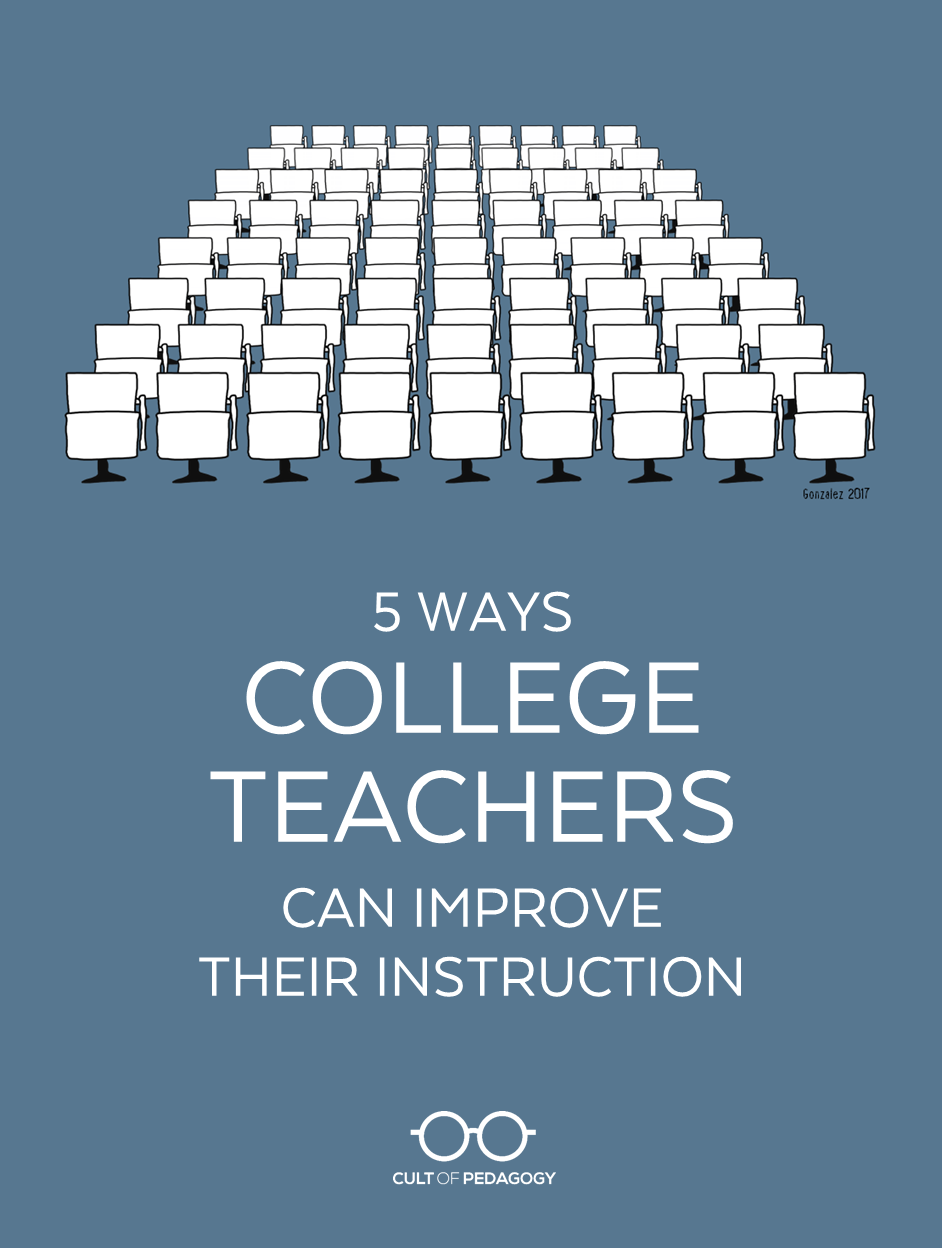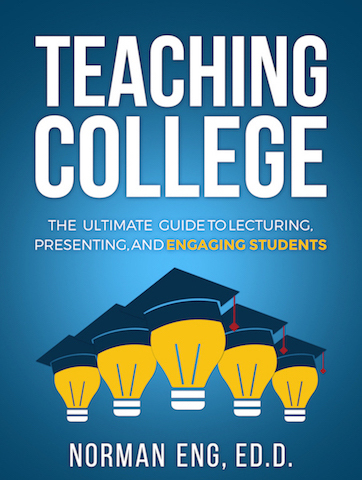
Listen to my interview with Norman Eng (transcript):
This post contains Amazon Affiliate links; if you purchase from Amazon after going through these links, Cult of Pedagogy receives a small commission at no extra cost to you.
I’ve always been bothered by the fact that at the college level, where students pay a lot of money for their education, the people who do the teaching have little to no training in teaching methodology. Colleges and universities place a high premium on a person’s expertise in their field, but they often require no teaching experience or formal preparation in pedagogy.
This is a problem. Because knowledge of subject area is just half of what’s needed to teach well. Teachers who haven’t learned the most basic principles of instruction are doomed to repeat the mistakes of those who came before them, delivering content with the driest, most ineffective methods possible, then wondering why their students aren’t more excited to learn.

Norman Eng, Ed.D.
Norman Eng is attempting to solve this problem. With his book, Teaching College: The Ultimate Guide to Lecturing, Presenting, and Engaging Students, Eng shows college instructors and professors exactly how to be successful at teaching college students.
This is not the first book that’s been written on the subject. But Norman Eng is unique for two reasons.
First, he was a K-12 teacher before he taught at the college level, which gives him a solid background in pedagogy. That’s significant on its own, and would probably be enough to fill a pretty good book on college teaching.
The second thing about Eng—his background as a marketing executive—is what really makes this book different. Eng has spent a good part of his professional life studying how to reach people, how to communicate a message, how to get the attention of a highly distracted audience. So when he moved into teaching at the college level, he saw how marketing principles could be applied to the classroom.
In Teaching College, Eng blends good pedagogy and marketing insights into a handbook that will help anyone who teaches college, or even high school, teach more effectively. In our podcast interview, he shared five specific strategies college teachers could use to dramatically improve their instruction.
1. Create a Student Avatar
“Instructors have to know who they’re teaching,” Eng says. “And I don’t mean basic information like My students want to go into business or My students want to go into journalism. Instructors need to know what actually drives their students, what matters to them.”
One way instructors can do this is to create a student avatar, a term used in marketing to describe a fictional ideal customer, someone who embodies a set of characteristics typical of a company’s target audience. Doing this exercise as a teacher helps you narrow your focus to a single student. This focus boosts your ability to shape instruction for that student, and this ultimately improves the experience for all of them.
“In marketing,” Eng says, “we do this when we actually have a product, we think about who is our perfect target audience. And this perfect target audience isn’t like talking about a group of people. It’s actually talking about one person. It actually describes the audience’s demographics like their gender, their age, as well as their psychographics, which is more like their attitudes and beliefs.”
Based on what he knows about his own student population, Eng has created this avatar:
Betty is a 20-year-old Latina from a working class family who commutes to college, lives with her parents, and works part time. She works hard but is often overwhelmed, because she takes five classes per semester to qualify for financial aid. She has one younger sibling and is concerned with passing the new, harder teacher certification and teacher performance assessments. Although she loves working with children, she’s not sure if she can handle the rigors of teaching in an urban public school classroom with its diverse student needs.
To create an accurate avatar, it’s important to actually learn about your students. If you’re in a new position, ask other faculty members to share their insights.
You should also, as Eng does, ask your students. “On the first day of class, especially if it’s a new course that I haven’t taught before, I will ask them, What is the most important thing that you want to get out of this class or program? What are some of the obstacles that you face? What one thing do you wish all professors knew about the way you work? And then you take all that information and you find the patterns. That’s how you create that avatar.”
Once that avatar is created, it should guide most of your instructional decisions. “It’s going to influence how you plan your course and your lessons,” Eng says, “because you’re asking questions like, Will she understand my lesson if I plan it this way? or What examples can I use so that she can identify with it?”
2. Use Tent Cards to Remember Names
Building supportive relationships with students has far-reaching effects on their engagement in class. One way to help this along is to learn students’ names. But in colleges and universities, where class size can reach the hundreds, this task may seem impossible. To meet that challenge, Eng recommends using two-sided tent cards.
“Take a 5×8 index card, and fold it in half so that it’s long,” Eng explains. Folded this way, it can stand on its own. “Write the student’s name on both sides of the card with a marker, so that when a student is talking, and their tent is on their table, students behind that person can actually see their names.”
Obviously, these cards will help the instructor call students by name, but they should also be used to help students engage with each other. In every class meeting, Eng reminds students to refer to their classmates by name. Although this can feel forced at first, students will eventually learn each other’s names and it will come naturally to them.
3. Implement “Cold Calling” and “No Opt Out”
Lack of student participation is a common complaint among college instructors. To address this, Eng uses two strategies from Doug Lemov’s book, Teach Like a Champion: Cold Calling and No Opt Out.
With Cold Calling, instead of calling only on students who volunteer, the instructor “cold calls” students randomly, including those whose hands are down. “But you can’t use this technique to kind of catch students when they’re not focusing,” Eng warns. “You can’t say, ‘Oh, John, what’s the answer?’ just because you saw that he was on his phone or whatever. Because the minute you do that, they’ll resent you for it. It has to be done in good faith. It has to give everyone a chance to shine.”
Eng adds that this approach will not work unless teachers use it in every class. “If you don’t, students might feel like they can still kind of get away with not raising their hands.”
The second strategy, No Opt Out, is used when students give an “I don’t know” response. “Students are trained to know that when I say, ‘I don’t know,’ the teacher will probably call on someone else, and they can just keep saying ‘I don’t know’ and never have to participate,” Eng says. Instead of letting this happen, “Pose that same question to another student, and then go back to the first student and ask him or her to repeat it or rephrase the response. This holds that student accountable for listening. So if you say, ‘John, what are one of the causes of World War I?’ and John says, ‘I don’t know,’ then you go to someone else, let’s say Shana, and say, ‘Shana, can you help John out? What’s the answer?’ and then she says whatever her answer is, and then you go back to John, and you say, ‘John, did that make sense? Can you repeat what Shana said?’ or ‘Can you rephrase what Shana said? or my favorite is, ‘Can you add to that?’”
Both of these strategies will work best if you already have a good relationship with students. “The truth is that I’m very conscious about using it,” Eng says. “I know that there are certain students that have a lot of issues with being put on the spot and being very shy…if you don’t know your students, then (these strategies) will just seem like you’re imposing.”
4. Deploy the QQC Strategy for Readings
Students not doing the required reading? Eng addresses this problem with something he calls the Questions, Quotations, and Comments Strategy (QQC). “Basically, students respond to the readings in a very short way, just by jotting down either a question they had about the reading, a quotation they found interesting from the reading, or a comment or reaction that they had to a particular section of their reading. Or maybe all three of those.”
The key, Eng says, is to keep it short, so that you’re not creating a whole extra task for students to do on top of the reading.
The other piece that keeps this strategy effective is to hold students accountable. “Follow up in class,” Eng says. “Every single class. If you could reserve maybe the last 15 minutes of class or the beginning 15 minutes of class to just kind of randomly ask students to share their questions, comments and quotations, then it will work.”
To build in further accountability, Eng also gives points for this work. But rather than collect the QQCs every time, he has students log them in a single document over a period of time, then collects that document twice a semester for a grade.

5. Put the Lecture at the End
A typical college class starts with some kind of lecture, and maybe after that, the students will be invited to discuss or apply the concepts being taught. If teachers flip this sequence, starting with some kind of engaging activity and then following it up with direct instruction, students will have a context for the information and will be more engaged.
“There’s so much research in education right now that talks about how students won’t understand something unless they can place it within the context of their life,” Eng says. By simply starting class with a meaningful discussion, question, challenge, or activity, students’ minds will be primed for the instruction.
Here’s an example: When teaching about philosophers John Locke and Jean-Jacques Rousseau and their differing beliefs on child development, Eng did not start class by lecturing on their theories. “I didn’t even bring up their names,” he says. “Instead, I asked my students, ‘How did you guys grow up?’ I wanted to kind of hear their experiences with discipline, with school work, you know, how their parents raised them. This led into a rich discussion about different philosophies of parenting and teaching, and that in turn led into the lecture on Locke and Rousseau.”
This example gave me goose bumps. I’m picturing Eng’s students, who have sat through hundreds of college classes that all basically start the same way. They show up, expecting a dry lecture, gripping their coffee cups in hopes they can stay awake, and they are met instead with this question. Totally unexpected. The rest of the world, for moment, would completely drop away.
That’s the kind of attention an exceptional college professor gets from their students.
And with just a bit of creativity, it’s something you could achieve in every single class. Even if you’re in the middle of a semester right now, even if your course calendar is tightly planned, this is a strategy you can start to use right away.
Bonus: Design Meaningful Experiences
Layered on top of these five strategies is Eng’s final piece of advice to college teachers, which he says is more of a shift in mindset than a specific technique.
“Think of your role less as a ‘teacher’ in the traditional sense of that word, and more as a designer of meaningful experiences. Next time you’re planning a lesson, think about what experience can you create that’ll allow students to understand the content. Maybe it’s group collaboration, maybe it’s a debate, maybe it’s a demonstration or a video or even a field trip. We’re all trying to cover the curriculum, and you’ll never have enough time for that. Focus instead on creating meaningful experiences every single class, because that shift in mindset, I’m positive, will put you in that elite status of instructors and professors.” ♦
These tips just scratch the surface of what Norman Eng can do to help you improve your instruction. Visit his website at normaneng.org and check out his book, Teaching College: The Ultimate Guide to Lecturing, Presenting, and Engaging Students.
Join my mailing list and get weekly tips, tools, and inspiration—in quick, bite-sized packages—all geared toward making your teaching more effective and fun. You’ll also get access to my members-only library of free downloadable resources, including my e-booklet, 20 Ways to Cut Your Grading Time in Half, which has helped thousands of teachers spend less time grading!






This is great, Jennifer–thank you! #3 is such a good idea!
Useful
Thank you, thank you, thank you, Jenn, for realizing the importance of college professors needing more training in teaching methodologies and strategies. My full time gig is middle school language arts, but I also teach adjunct in the college of education. It drives me crazy to see so many well-intentioned professors, full of amazing context knowledge, but not have a clue as to how to meaningfully reach their students. I will certainly be sharing this post!
Thank you for sharing this. As a long time elementary educator and administrator I find now that I am teaching the preservice early literacy class for a university, I use my previous strategies and they work well. I focus on the four C’s of learning: communication, collaboration, creativity, and critical thinking. That means every single class I teach requires students to talk to each other in small groups and share out. I facilitate this by using playing cards numbered one
through four (or six depending on the size of the class)that students pick up as they enter class. This creates random groups each week. Once the problem, article, whatever has been presented it is discussed in the small groups and I pick a stick with a number and the person with that number in each group shares out the group’s findings. This has accountability built in while allowing all voices to be heard. I prefer this to putting someone on the spot with cold calling. I so enjoy your website and appreciate your articles and information.
Still love the Marigold article and I have my own marigold shirt.
Thank you thank you thank you! I will be using a couple of these strategies on Monday with my AP class. LOVE the QQC strategy- ensures students do their homework without a ton of grading on my part! These are really relatable to high school as well, especially AP classes!
Oh!As usual, there is so much I can use from this post, both as a senior school teacher and as a Head of Department! I guess #1 is the key. Knowing who your students are and what they want and need will result in meaningful lessons, which will make them want to participate. I definitely intend to use the QQC with my Year 11 and 12 Language and Literature students, and the “No Opt Out” with, well…, everybody! I hate it when students say “I don’t know”. Always feel that what they are really saying is “I don’ t know the perfect answer that will make you happy” or ” I lack confidence in my own ideas”. And so I worry…and try to find a better way to teach them.
You’ve passed along somegood stuff since I’ve subscribed, but this has been my favorite. Thank you!
Love the QQC!! Teach 6th grade, but all of these are super important! (“Super” having to be added in front of every adjective in 6th grade, sorry people…)
I really appreciated this podcast. When I got your original email about Dr. Eng’s book I immediately downloaded it! Hearing Dr. Eng describe what he did, how and why, brings the text home for me. As I thought about it, I recalled “starting” some of the activities he mentioned in classes years ago, but not knowing where to go after the beginning or realizing that I needed to consistently sustain it!
I have subscribed to his email list and will continue to make adjustments in my teaching practices. Thank you so much for this information!
Wow! I want that book… Do you perhaps know when the book is published in Europe? 🙂
Hi Liz! This is Debbie, a CoP Customer Experience Manager. We heard back from Norman Eng and he said Teaching College is available in Europe in the following markets through Amazon: Amazon.co.uk Amazon.de Amazon.fr Amazon.es Amazon.it and Amazon.nl I hope this helps!
Thank you, guys!!!!
I’m a little like Norman in that my background for the last 30+ years is in public relations, not necessarily teaching. But for the last seven years I’ve taught one class at Calvin College, my employer, a PR and advertising class, and I’ve taught it probably a little differently than most would because of my PR background. Eng’s avatars are my personas. His QQCs are my haiku and reflection (yes, I have students summarize the reading in a haiku!). So it was nice to see that what he recommends, I’m already doing a little. Also his tent card idea is excellent. I’m not good with names, and I love how his idea serves both the instructor and fellow students. Thanks for a highly applicable and also affirming post!
In my experience as a college and graduate student, teaching was considered the lowly part of the job for many professors. That’s one of the main reasons why I decided to teach high school and not college! These are great tips, but what I love most about this is the obvious concern for students.
This is fantastic and I LOVE this topic. I was formerly in sales and marketing before teaching and have found so much use out of the presentation and interpersonal training I received there.
I am currently reading Carmine Gallo’s “Talk Like Ted” book and will be posting my review of it at my site. This book is a gold mine related to this topic.
The book talks about how the best in business, academia, science, politics, get people’s attention and get them to remember things using tested techniques. They have their audiences hooked up to brain scans and all kinds of tools to test which techniques are best.
Of course teachers could benefit greatly from this! This is 1 of my 61 (and growing) skills and habits I wish I were taught in teacher training and why I view personal development as about 10x more valuable than professional development.
Love your site and your topics! Thank you.
This post totally resonated with me as I currently teach 3 community college classes now, 2 of which I never thought I’d have to address behavior in a college syllabus, but sure wish I did earlier! I actually just finished a draft on why K-12 educators were the perfect match for teaching at community colleges. Are you currently accepting guest bloggers? I noticed you’ve listed several from reading your site, and I’d love to contribute to this very topic.
Hi, Melissa! This is Holly Burcham, a Customer Experience Manager. I teach at the adjunct level myself, but I have certification to teach 6-12 grade ELA. I’m right there with you!
Please head over to our Contact Us page and send us an email with this same question; we’ll continue the conversation that way. Thanks!
Thanks for sharing about Dr. Eng’s book! I’ve just submitted a purchase request to my institution’s library system to acquire this book.
Plus I loved the practical tip for making a table tent out of a 5″x8″ index card–I’d always had students fold up a piece of notebook paper, which was much too floppy!
I am a professional who has recently converted to teaching at the graduate level. I really had no idea what I was doing, but I want to make the classroom experience interesting and engaging for not only my students but myself as well! We are using Blackboard, and I had planned to do a weekly discussion question, but I like the idea of incorporating the QQC into a Blackboard discussion forum for the required reading. I also plan to pass out index cards on the first day of class and ask the students specific questions about their likes and dislikes to get to know their learning styles a little bit better.
Listened to the book Teaching College yesterday. I teach year 9 to year 12. This book is so useful. Thanks so much Jennifer for introducing me to It!! I had already tried out QQC and thoroughly enjoyed the book. Like you , I wanted to re write my course information for Year 12 using his suggestions on writing a syllabus.
You’re so welcome, Lyn!
Great post Jenn! I agree that this is an important issue in higher education. As someone who has taught both in the K-12 and postsecondary settings, I have experienced many higher education instructors with underdeveloped teaching skills. I think that Norman Eng’s five tips provide a wonderful starting point for these instructors to engage students with the subject matter they know so well.
His tips reminded me of several quality professors I had or knew about during college. Mike Leckrone, the university marching band director, is not only famed for the amazing bands he’s directed, but also for remembering his band members’ names. I have heard that Leckrone would even know the names of everyone trying out for the marching band ahead of the first tryout, before he’d even had a chance to meet them. I don’t know what strategy Mike Leckrone used to memorize all his students’ names, but it is evident that he valued knowing his students personally and put in the effort to do so. And this made a big difference for students.
Another professor, Steve Stern, in the UW-Madison history department would break up his lectures into appetizer, main course, and dessert sections. This followed the sound practice of having pre, during, and post activities as part of an effective lesson. The appetizer section was meant to whet the appetite and get students excited about the lesson. The dessert provided them with a question to extend learning, a quick formative assessment, or some other final thought. While the middle part of the lesson was a standard lecture, these divisions made a big difference for student engagement and helped create the meaningful experiences Dr. Eng is talking about.
As a final thought, there’s also something to be said for just having a lot of knowledge about your subject and surprising your students. Stanley Payne, is a well-known scholar of the Spanish Civil War who I was fortunate to have as a professor. If his sheer knowledge and expertise wasn’t enough to make you pay attention, it was the fear of missing a bit of his humor. More than once, as I sat there dozing off, I’d be brought back to life by other students chuckling at something Dr. Payne said. It was enough to motivate me to pay closer attention next time. So the use of humor always helps.
Thanks again for the post!
LOVE these stories, Eric — something in each one that we can all learn from. Thanks so much for sharing!
I actually do not agree with the cold calling. I understand that encourages class participation, but there are better ways of engaging students. Cold calling is a tricky situation because the instructor uses their position of power to force a student to contribute. I think it is often seen as a trait of a good instructor, but to me, it creates an atmosphere of fear. When I was a student, I would get palpitations when the instructor is looking for students to answer his/her question. If I were to call on a student, it seems to me that I am communicating, “I don’t care about your preference whether or not you would like to contribute. I’ll use my power to force you to do so anyway.”
I think the teacher teaches students how to think and feel about cold calling. I told my students that I care what they have to say, and I have faith in the value of their contributions, and that’s why I cold call. Some people just need to be asked before they have the courage to share their thoughts.
Important—the article states that it shouldn’t be used as a gotcha. It’s consistent like a toll booth, not a weapon like a speed trap.
I also share with my students that everyone needs accountability to produce their best work—even me— and the cold call is one way to provide that support every day.
Hi! Long time reader, first time commenter. I just want to say I appreciate this post as a recent graduate student and HS sped teacher with 2.5 years of classroom experience. I spent two graduate years at a “prestigious, catholic university” where the majority of the professors were really cut and dry.
I will always remember this one professor I had because she had refused to remember anyone’s names for a whole semester, preferring to use eye contact and finger pointing to call on us. We were a cohort of 20 or so students who more or less always sat in the same spots so it really boiled my blood. Especially when she expected us to participate wholeheartedly! “Students don’t care what you know until they know you care!” Rings true for students of all ages.
Eventually, this led me to resent her because I knew what good teaching could look like and that wasn’t it at all! On the plus side, it confirmed something for me…I learned that I never NOT want to know who is sitting in my classroom. No matter what other responsibilities I have, no matter if they’re gen ed or sped students, I will always want to learn who my students are (and now, thanks to your 360 spreadsheet, it’s easy for me to record and remember!)
I look forward to reading this book as I aspire one day to be a university professor…I mean, a designer of meaningful experiences! I really like this term and may use it from now on. Thank you for your blog, your expertise, and your ability to bring other viewpoints and amazing strategies to us!
Thanks so much for sharing this, Krys! I had a lot of great teachers growing up, but the ones that weren’t so great were the big reasons behind why I wanted to be that much better in what I did for kids – I get it! Glad you’re enjoying the site and Jenn’s resources; I’ll be sure to let her know. Thanks!
College Prof here.
Recently, I was our colleges Staff Development coordinator for my college, which meant I was charged with planning, implementing, and coordinating trainings for our faculty, staff, and management.
These are some great tips.
While I was in staff dev., we implemented Instructional Skills Workshop (ISW), a program designed in Canada to combat this very problem.
ISW is foundational, teaching faculty how to lession plan and scaffold, as well as sharing effective strategies like Eng.
Just thought I’d share in case someone was looking for a great idea for training.
Thanks for posting this, Jennifer! I’ve spent 13 years teaching at the 2nd-6th grade levels, but I have been thinking of teaching at the community college level. This article is further inspiring me to look into a career change. I love Mr. Eng’s advice and will check out his website. Thank you for sharing his info. Keep up the great work, Jennifer!
Thank you for these useful ideas!!!
I’ve been teaching community college for almost 10 years now. Community colleges do train their instructors. In fact they provide a lot of great training.
I really disagree with his avatar thing. Students come in all shapes sizes and flavours. Creating an avatar will result in focussing on 1/3 or 1/2 of your class to the detriment of the other 2/3 or 1/2. Ultimately as a community college instructor I have to address everyone in the class from the 16-year-old who’s a dual enrolment student to the 70-year-old who is there because they want to try something new, They all deserve to be reached. So I disagree with the author.
There are many tricks, many strategies, many approaches available and I have been using most of them because I had good training at all of the jobs I’ve had at community colleges, all of which has been provided for free. From the reading apprenticeship (which is amazing), to Learning by Design, to so called flipping the classroom, to active and project-based learning, to service learning, to incorporating technology, we get trained in the Vanguard of teaching and learning. We have some of the best instructors I have ever seen, and many of my colleagues have PhD‘s in education and other fields.
I don’t think anyone can learn these techniques from a book or a short five point list. I need to attend a good workshop and then a few more. They may have to attend them at a community college because that’s where the latest and most inventive training is. Lecture scmecture, we’re supposed to move away from the “sage on the stage as much as we can“.
I hear you. That sounds like you need two or more avatars, not none. Can you name the constraints, motivations, and concerns of the 16 and the 70 year old the way Eng did, and use that info to create meaningful learning experiences fit both/each? Is there a 3rd category of student, perhaps 18-22, in your room? That’s the push, I think.
I used to be shocked when I would hear this. Because I had lots of instruction on teaching in my masters and Ph.D programs. Then someone reminded me that my programs were in the school of education and my discipline is psychology. So, of course, it was part of my education.
I found out I would be an adjunct professor in late June of this year with a start in August. I found this article and podcast episode by finding Jennifer on Twitter and asking her for advice on resources. I listened to this episode twice, bought Norman’s book (on Audible and print version) and read it once and listened to it twice.
I used tips 1-4 and as well as trying to design each three-hour class as a meaningful experience. This episode/article was very, very helpful in allowing me to at least have a foundation to get started. I love it! I would also love to discover a college teaching mastermind if there are any out theree?
Thanks for re-posting this. A great reminder.
One question and one comment. Having students who may haggle over a point… how do you encourage students to do a Q and a C and a Q (or reward students who do) without going crazy keeping score? I can see awarding 2-3 points for one entry but how do you do better than an A for a semester grade if a student consistently provides two or more responses each week?
Also… I have students take pictures of the person next to them (they all have their cell phones anyway) and send them to my email address with the person’s name. That way I get a visual that I end up downloading into a file with corresponding names. It takes a bit of time to download the pictures so this wouldn’t work with a large class, but that reinforces my matching the student name and face. I reassure students that I don’t have FB or any social media (I don’t) and their pictures will be confidential. And students at least get to meet somebody else the first day of class.
I guess if a group was willing, larger groups could post pictures to a class Google drive.
Hi Deb! I’ll be honest, when I use QQC, I don’t require students to do more than one (meaning they can leave a question, comment, or quotation; not all three or even two of them). Having to record all three does add work. Another option is for students to record their QQCs on Google Sheets. This way, THEY record. There are upsides to this, as well as potential downsides (they have the ability to edit the sheet). I’m open to suggestions!
#5. At workshops and in class, I prefer the lecture or at least a mention of the lead/aim/topic before the general questions. I personally cannot efficiently organize the rest of the information without it. That said, a rotation or combination would definitely be benificial for all of the students.
☆
LOVE LOVE LOVE #3 and #4.
This is quite misleading as most colleges and universities have ongoing professional development in pedagogy and the use of tech in teaching in their Centers for Teaching and Learning (sometimes called something similar) and in ongoing workshops, convocations, etc. College teachers like Arthur Chickering have been researching and writing about college teaching since 1969. Ken Bain has also contributed over a decade ago with What the Best College Teachers Do. Our Center for Teaching and Learning used his book in our brown-bag book club, meeting weekly to discuss his ideas. Claiming college profs are not offered training in pedagogy is fallacious, maybe just to promote this otherwise informative podcast or maybe just to pitch Eng’s book? Our biggest problem in running workshops is the unwillingness of some faculty to attend. That’s not a failing of the college.
Hi Cheryl, maybe it’s more accurate to say that pedagogical training isn’t a requirement to teach college courses the way it is for K-12. Teacher training acts as more a supplement, and as such, new professors (many teachers) come into the classroom with little knowledge or experience of how to engage students. The lucky ones or the ones who do have teaching & learning centers may experience a workshop or two before their first course. Which isn’t the same as 4 years of formal K-12 education training. That’s what I’m really comparing to. And when training isn’t mandatory, some will come and some won’t, as you alluded to, which makes T&L centers less effective than they could be. Should there be mandatory pedagogical training? Might be an interesting idea. Chickering and Bain all do great stuff, but they are not formal professional development or teacher training on every single campus–it is up to individual instructors to seek out their Bain’s work. And while many more IHEs do have T&L centers, there are many more that still don’t or are in the process of creating one. And what about adjuncts? They make up a significant amount of the higher ed instructors and many are hired a week (or days) before class starts. They’re coming in cold. Who’s training them? I see, hear from, and read about these instructors often. T&L centers may have workshops on specific days that adjuncts will have to wait for–sometimes months before they get training. Sure, they can walk in and get some help. Maybe. Depending on the T&L centers. My point was less about the fact that there isn’t pedagogical training–I’ll concede to that–and more about the fact that there isn’t a widespread concerted and active effort to prepare teachers before teaching their first course. For many that are unwilling to go, there are plenty who simply don’t know. Which means the T&L at that institution (or the concept of pedagogical training in general) hasn’t reached critical mass or isn’t robust enough for new teachers to know to go too–the way that it is in K-12. In the end, the training process for professors is not formalized, standardized, or widespread enough to make the general statement that “college professors have pedagogical training.”
informative. thank you. I am grappling with the college students, now online, not being present. I have suggested that students not be required to be online as long as they produce the required work.
Great podcast. I enjoyed this tremendously. I’ve actually used point # 5 and it does make a big difference in participation and interest levels. I look forward to reviewing more of these inciteful podcast.